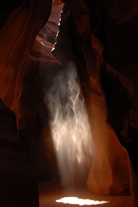RJS_9820r.jpg
Antelope Canyon Photography by Ronald J. Saunders
All images and text are Copyright protected
copyright © 2008 Ronald J. Saunders
Technical (somewhat)
Simply put, this is a low light situation where some thought will help you achieve remarkable results. First of all, a tripod is mandatory and firing your camera remotely is useful but not manatory. Exposure times will be in the order of sub-second to as long as several minutes, so consider a good sturdy tripod. The canyon floor is sand and provides quick tripod placement and movement. Getting the light beam in focus is not going to be your main concern. In most cases you are going to need to pay attention to depth of field which can only be achieve by a small aperture which in turn leads to long exposure times. I recommend an aperture priority mode setting
For most of my images, I used an aperture of f/13 or f/18. I don’t think that you should be any wider for acceptable depth of field. Even smaller apertures are very desirable but the canyon can be quite crowded with tourists and the exposure times that I experienced were in the range of one-half second to 20 seconds. The best images will be obtained at f/22 or smaller if conditions tolerate the longer exposure time which can be several minutes. There is a pretty high risk that someone is going to ghost through your image during a several minute long exposure. Using your aperture priority mode is a good way to set your depth of field requirement to f/13 or narrower. Remember, any aperture smaller than this is going to help significantly with the image quality.
PixXDim : 2592
Equip Model : NIKON D200�
F-Number : F/13
Artist : Ronald J. Saunders�
Exposure Time : 0.05
Flash : Flash did not fire
Focal Length : 27
ISO Speed : ISO-200
Metering Mode : Pattern
Date Time : 2008:05:31 14:59:42�
MaxAperture : 4/1
Equip Make : NIKON CORPORATION�
PixYDim : 3872
